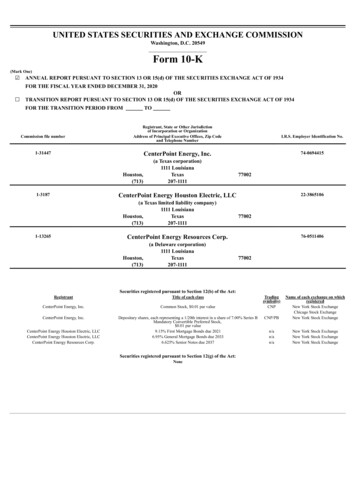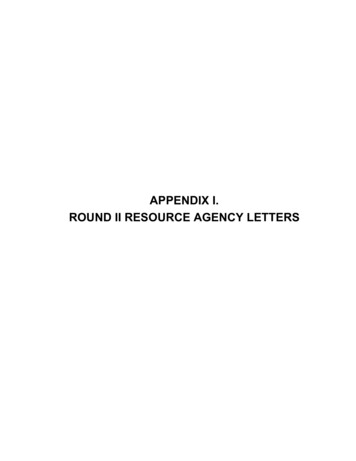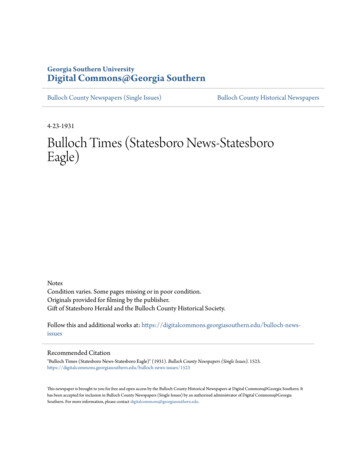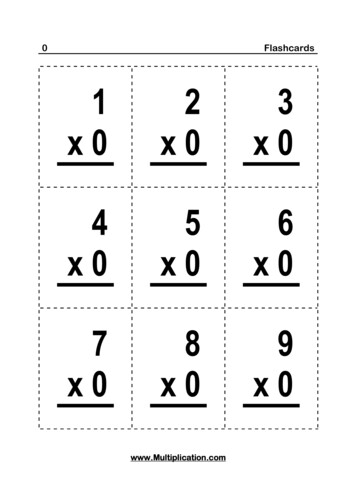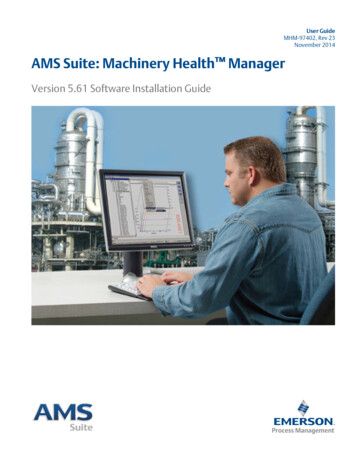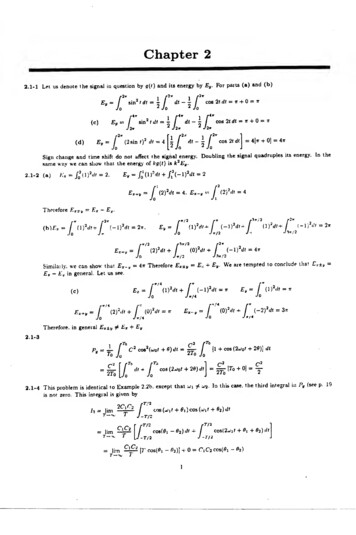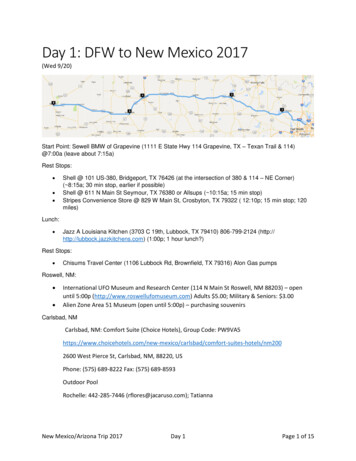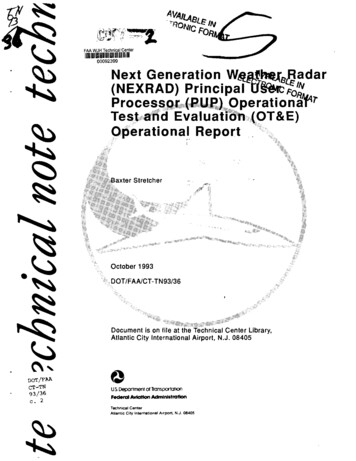
Transcription
i ''f ;ii; 'II11,,\"" "' ;.\v .iJ} I 1.1 .- .1"FAA WJH Technical Center1111 IIIIIIIIUIIII U11 II IU IIIIII100092399Next Generation W@jJ.( 8 adar(NEXRAD) prinCipal-tJ F Proceperationa rTeEvalua&E). erationa Reportaxter StretcherOctober 1993DOT/FAA/CT-TN93/36Document is on file atCenter Library,Atlantic City International Airport, N.J. 08405DOT/FAACT-TN93/ 36c. 2US Department ot Tran,portatlOO.-ral Aviation AdmlnlstrallonTechnical CenterAtlantic City International A,rpOM, N.J. 08405
DOT/FAACT-TN93/36c. 2Stretcher, BaxterNext generation weather radar(NEXRAD) principal user proc essor (PUP) operational .NOTICEThis document Is disseminated under the sponsorshipof the U.S. Department of Transportation in the interest ofInformation exchange. The Un ed States Govemmentassumes no liability for the contents or use thereof.The Un ed States Govemment does not endorseproducts or manufacturers. Trade or manufacturers'names appear herein solely because they are consideredessential to the objective of this report.
Technic.' R.rt O.cu.fafl.n Pag.1. .II."2. G.,,,"".", "'ce ,o" N No.3. R.etll'."' C.,olo, N .DOT/FAA/CT-TN93/36.roll. and S",bl,d.S.A. ar6. P."."",nl 0'90,ulo'lon Code8. P."O''''''''I 0'IOlt'10',0", .oo" No.IIDOT/FAA/CT-TN93/36Baxter Stretcher9P.rlat"""1O'l'"10. won.10"Olt Na",., U.S. Depar ment of TransportationFederal Aviation Administrationw"'""'40. ITRAI5111 CO"'''oe' 0' G.O"' N .Technical CenterAtlantic City International Airport, NJ 084051&D.,.October 1993NEXT GENERATION WEATHER RADAR (NEXRAD) PRINCIPALUSER PROCESSOR (PUP) OPERATIONAL TEST ANDEVALUATION (Oro,E) OPERATIONAL REPORT7 .porr13. TYIIO.f .II.tI o"d P."od C.oS"O"bO""9At.ney "'40"'. ond Ad.'.epar ment of Transportat1on. .Technical NoteFederal Aviation AdministrationTechnical CenterAtlantic City International Airport, NJ 08405. SP."'.""'.AI."'C, Cod.IS. 51,,1110l.""."'or, N., I'. Alit.tractThis report details the results of the Operational Test and Evaluation (Oro,E)Operational Test of the Next Generation Weather Radar (NEXRAD) , Principle UserProcessor (PUP) . The PUP was evaluated at the Leesburg, Virginia, and Houston,Texas, Air Route Traffic Control Centers (ARTCC) during the period March 22 throughApril 1, 1993.The objective of the OT&E Operational Test was to obtain the Central WeatherService Unit (CWSU) meteorologists' evaluation of the NEXRAD PUP. A questionnairewas used to obtain responses from the meteorologists.This report includes the meteorologists' evaluation of the quality and quantity ofthe products provided by the PUP, the workload, operational procedures, radarconnections. and training.1.17. lC., .,d.Next Generation Weather Radar (NEXRAD)Principle User Processor (PUP)Central t.:eather Service Unit (CWSU)19. S.e",,'" CI d. 1of "'" '0",')UnclassifiedFor'" DOT F 1700.7 6 7211Il. S.CVl'l"Oi.", ., St.t.Document is on file at the TechnicalCenter Library, Atlantic CityInternational Airport, NJ 08405CI."I'. (.f th. , . . .)UnclassifiedR.WC'I . . . f c.""I.,." . ,,"'.'1 "21. Ho. of Pa,o.3822. P.,c.
TABLE OF CONTENTSPageEXECUTIVE ticipantsTrainingEquipment222Evaluation QuestionnaireProcedure333AnalysisRESULTS AND DISCUSSION4PUP Weather ProductsPUP OperationsWorkloadTrainingOverall Effectiveness and S910ACRONYMS AND ABBREVIATIONSAPPENDICESANEXRAD PUP Evaluation QuestionnaireBParticipants' Responses and Commentsiii
EXECUTIVE SUMMARYThe Next Generation Weather Radar (NEXRAD) , Principal User Processor (PUP), wasevaluated at the Leesburg, Virginia, and Houston, Texas, Air Route Traffic ControlCenters (ARTCC) during the period March 22 through April I, 1993. This was thefirst Operational Test and Evaluation (OT&E) of the NEXRAD PUP in the CenterWeather Service Unit (CWSU) environment.The objective of the OT&E Operational Test was to obtain CWSU meteorologistevaluation of the NEXRAD PUP aviation weather products, equipment, operations, andworkload. A questionnaire was used to obtain responses from the meteorologistsrelative to the operational effectiveness and sUitability of the PUP.Highlights of the operational evaluation, and subsequent debriefings, are thefollowing: (1) The participants were satisfied with the quality of productsprovided via the PUP; (2) There was general agreement that the PUP provided themwith too many products, many which are not useful in CWSU operations; (3) The PUPincreased their workload; (4) Some of the operational procedures and functions weretoo time consuming for one operator to perform; (5) The lack of more than onedirectly connected radar was seen as operationally unsuitable; and (6) The trainingshould have focused more on the PUP procedures as related to CWSU activities, andless on nonaviation oriented meteorological subjects.It is recommended that a review of the PUP's procedures, functions, and personnelrequirements in the context of a CWSU environment be considered. It is alsorecommended that the training for the CWSU meteorologists be focused on the CWSUoperations and procedures. The results of this evaluation should be shared withthe Real-Time Weather Processor (RWP) Program Office for incorporation into the RWPSpecification.v
INTRODUCTIONPURPOSE.The purpose of this evaluation was to determine the operational suitability andeffectiveness of the Next Generation Weather Radar (NEXRAD) Principal UserProcessor (PUP) in providing aviation weather radar products to the Air RouteTraffic Control Center (ARTCC) Weather Service Unit (CWSU). The primary focus wasto assess the usefulness of the PUP, and the associated NEXRAD products in aidingthe CWSU personnel in detecting and forecasting aviation hazardous weather. Theevaluation was conducted by the Weather and Primary Radar Division, ACW-200D, ofthe Federal Aviation Administration (FAA) Technical Center. The plan for thisevaluation is detailed in the FAA Technical Center's "Next Generation Weather Radar(NEXRAD) Principal User Processor (PUP) Operational Test and Evaluation (OT&E)Operational Test Plan."The NEXRAD system is an "S"-band doppler weather radar system developed bythe Paramax Corporation. This system is designed to provide information onenvironmental wind profiles, and to detect wind shear and other hazardous weatherphenomena for the Department of Transportation (DOT), and also to perform otherfunctions for the Department of Defense (DOD) and the Department of Commerce (DOC).BACKGROUND.In October of 1983, the NEXRAD Program Council (NPC) requested that the Air ForceOperational Test and Evaluation Center (AFOTEC) conduct the NEXRAD InitialOperational Test and Evaluation (IOT&E). To facilitate this, an integratedtridepartmental test team under the management of AFOTEC signed a Memorandum ofAgreement (MOA) in April of 1984. The test team consisted of the DOC, the DOD, andthe DOT. The NEXRAD Test and Evaluation Master Plan (TEMP) was coordinated andapproved by all participating agencies in March of 1985. The TEMP detailed theresponsibilities of the participants and the general IOT&E scenario. A second MOAwas signed by the NPC members and the AFOTEC commander on November 1988, andfocused on IOT&E(2).Two independent test teams, under the overall management of the AFOTEC, conductedIOT&E of the competing contractors' (Raytheon and Unisys, formerly Sperry) NEXRADunits.Unisys was selected as the production contractor, and preparations wereinitiated for the IOT&E(2). A l60-member integrated tridepartmental test teamunder the management of AFOTEC conducted an IOT&E(2) on the Unisys (Paramax)preproduction NEXRAD system. The IOT&E(2) was divided into two parts (A and B).Part A combined activities from March to May 1989. Part B was a dedicated OT&Efrom May to August 1989. The DOC conducted their part of the test at the WeatherService Forecast Office (WSFO) in Norman, Oklahoma. The DOD conducted theirtesting at Tinker Air Force Base, Oklahoma, at the Base Weather Station. The DOT(FAA) completed their OT&E Operational Testing at the FAA Academy in Oklahoma City,Oklahoma.1
An agreement between Unisys and the government was reached, and Unisys (Paramax)was awarded the full production contract. Follow-on OT&E Operational Testing onthe full-production system was recommended by the Deployment Readiness Review (DRR)Committee to establish operational suitability of the system. This OT&EOperational Testing at the Washington and Houston ARTCC CWSUs fulfills thisrecommendation.METHODPARTICIPANTS.Eight CWSU meteorologists participated in this OT&E Operational Test. Four at theHouston ARTCC and four at the Washington ARTCC. Their current operational dutiesat their facilities are in the capacity of two Meteorologists in Charge (MIC)and six CWSU meteorologists.The eight meteorologists had a combined total of 85 years of CWSU experience and6.7 years of NEXRAD PUP operational experience.TRAINING.Seven of the eight meteorologists attended the 4-week Weather Surveillance Radar,1988 Doppler (WSR-88D) Operations Course given by the Operations Training Branch,at the Operational Support Facility (OSF) in Norman, OK. They received training onPUP and NEXRAD System operations, and interpretation of NEXRAD products andalgorithms, including principles of Doppler radar.EOUIPMENT.The PUP receives NEXRAD products from the Radar Product Generator (RPG) uponrequest from the operational personnel. The PUP is located in the ARTCC, while theRPG is located elsewhere, usually at the WSFO. The PUP contains the display unitfor product control, status monitoring, local annotation, and product archiving.The PUP has three major components: (1) the data processor, (2) the system console,and (3) the workstation.The data processor is a two-bay cabinet containing the necessary hardware/softwarefor all data processing activities. The cabinet also contains the narrow-bandlinks used between the PUP and its associated RPG for internal product request anddistribution, along with the dial-out port for external requests and distributionfrom nonassociated RPGs.The system console holds an alphanumeric terminal consisting of a keyboard and a14-inch Cathode Ray Tube (CRT) screen. The console is an interactive peripheraldevice connected to the display processor port on the data processor cabinet. Thefunctions provided by the console include system initialization and startup,control of the disk/tape operations, loading and execution of processor diagnosticprograms, and start/stop of the system's application software.2
The workstation is the primary operational position for the PUP. It provides themeteorologist with the capability to request, display, and manipulate weatherproducts generated by the RPG. The workstation consists of a table structure withoperator work space and support provisions for an application terminal, two colormonitors, a graphic tablet, and an audio alarm. A hard copy device is alsoprovided on a separate table that may be positioned up to 50 feet from theworkstation.EVALUATION QUESTIONNAIRE.In order to obtain feedback from the meteorologists, a questionnaire was developedand administered by the FAA Technical Center, ACW-200D (appendix A). Thequestionnaire was structured to obtain an evaluation of the operational suitabilityand effectiveness of the NEXRAD PUP and the associated NEXRAD products in anaviation onV'SectionThe questionnaire consists of the following five sections:PUP Weather ProductsFAA PUP OperationsWorkloadTrainingOverall Operational Effectiveness and SuitabilityThe questionnaire was structured to obtain an evaluation by rating a statementDisagree, Neutral, or Agree, or by Yes or No. Comments were encouraged. Open ended questions were also asked on several issues in order to obtain comprehensivefeedback.PROCEDURE.On November 19, 1992, an initial site visit was made to the Washington ARTCC CWSUto obtain specific information necessary to conduct the evaluation.Informationthat was obtained included the number of meteorologists that would participate,layout of the CWSU area, display equipment being used, duty schedule ofparticipants, and other pertinent information. Since the Washington ARTCC CWSUis similar to the Houston ARTCC CWSU, the information from this visit wassufficient for both sites.The OT&E of the NEXRAD PUP took place at the Washington ARTCC CWSU, the week ofMarch 22, 1993, and at the Houston ARTCC CWSU, the week of March 29, 1993. The FAATechnical Center representative provided adequate copies of the questionnaire tothe MIC, and insured that each participant was briefed concerning the intent of theevaluation, and that all questions and concerns were addressed. The briefings wereheld on an as needed basis to cover all duty shifts. After the questionnaires werecompleted, debriefings in which the respondents could express any additionalcomments or concerns Were informally conducted.During these debriefings,discussions resulted which related to suggested changes and improvements. Thisreport includes any additional information relayed during these debriefings.ANALYSIS.The responses to the questionnaires have been tabulated to give the numberof Yes or No, or Agree, Disagree, or Neutral responses as compared with thetotal number of responses.Five or more positive responses were rated asOperationally Acceptable; four or less positive responses were rated as3
Operationally Unacceptable. Neutral responses are treated as negative responses.In addition to the numerical responses, comments were analyzed using contentanalysis to give additional input and are referred to as appropriate in the Resultsand Discussion section.Only seven of the eight meteorologists' responses were considered in the analysisas one did not attend the NEXRAD PUP training. (This was a requirement inaccordance with the NEXRAD PUP OT&E Operational Test Plan.)RESULTS AND DISCUSSIONAll of the meteorologists, at Leesburg, VA and Houston, TX, completed thequestionnaires. Both sites had similar equipment and staffing. The Results andDiscussion section follows the format of the questionnaire. Response totals andspecific comments to each question are shown in appendix B.PUP WEATHER PRODUCTS.Six of seven participants indicated by their positive responses that the NEXRADPUP provided the products needed for their operational duties in the CWSU(question #1). The respondent that said No, commented:"There are 3 altitudes on the layer reflectivity and turbulence products.mid altitude should be changed from 24,000-33,000 ft to 24,000-40,000 ftso we can view the reflectivity and turbulence at the altitudes flown bycommercial airliners in ARTCC Operations. IITheIt may be beneficial for the FAA to investigate whether the layer reflectivity andturbulence products could be adjusted for aviation purposes.The respondents indicated that some of the products provided were in excess oftheir needs for normal CWSU operations. This is reflected in the response to thequestion, "Are all of the products provided by the NEXRAD PUP necessary for youroperational duties in the CWSU?" (question #2). Their response was a unanimous No.At the debriefings, the meteorologists indicated that some established lists maycall up certain products that were not needed for the CWSU operations. Requestingthese extra products slowed down other operations. Some of the products therespondents had no need for included spectrum width, combined shear, 3 hours echotops, 3 hours precipitation, and storm totals. It was suggested that the problemmay be solved by using the Routine Product Set (RPS) list. This list allows theoperators to select the products that are useful and needed for their operation.The RPS list would be used as a part of their Standard Operating Procedure (SOP).It would take time to make a RPS list, but in the long run, it would save time inmany of their callup operations. Both HICs indicated that they are in the processof making their RPS list for their facilities. The sentiment that there were toomany products was reiterated in question #9, "Were the procedures for acquisitionand display of the FAA Air Traffic oriented products (such as layer products)adequate for your operational requirements?" This received an unacceptable rating,with three Yes responses, three No responses, and one Yes/No response. From theseresponses and comments, it appears that the procedure for the acquisition of4
the products was adequate but the products received were not adequate for themeteorologists. The respondents' comments on this question and question #2 seem toindicate that the procedure for the callup of aviation products resulted in displayof unnecessary products. This is a situation that may be resolved with the RPSlists becoming SOP.The respondents were asked about the timeliness of the alphanumeric and graphicproducts and the time between a weather event and the display of the event(questions #3, #4, and #5). Five of the meteorologists felt that the alphanumericproducts were provided in a timely manner and were an aid to their operations. Sixof the respondents agreed with this statement, "The time required for the system todisplay graphic products was reasonable." Six of the seven meteorologists alsoagreed that the time between the weather event and display of products wassatisfactory, which showed a high level of acceptance in all situations.Question #6 asked if the system adequately provided products under various scanstrategies. All seven of the meteorologists replied Yes.Questions #7 and #8 were similar questions asking about the use of the mouse withthe graphic tablet. Question #7, however, asked if the mouse/tablet was convenientto use for PUP procedures, whereas question #8 asked if the mouse/tablet was asuitable device in general. Only three of the seven meteorologists felt that itwas easy and convenient to use the mouse/tablet to select various products andperform different functions such as map overlays and graphic editing. On the otherhand, all seven of the meteorologists felt that the mouse/tablet was, in general,suitable in the CWSU operations. The debriefings and comments from the respondentsseem to indicate that while the mouse/tablet use is operationally acceptable, it isnot the preferred method of doing certain CWSU operations. The respondents feltthat they needed to become more familiar with the graphic tablet puck system (theprocedure of selecting products via way of the graphic tablet) so that it becomesless time consuming and easier to utilize, and that there were too many choices onthe tablet. Question #3, of section II of the questionnaire, reiterates thisresponse.Six of the respondents agreed that the hard copy device and the graphic displays(questions #10 and #11) were suitable and adequate for their CWSU operations. Thiswas an acceptable rating for this equipment.The statement: "The procedure to maintain a local data base containing theproducts that are used regularly within the CWSU, is reasonable (#12)," was ratedunacceptable with four agrees and three neutrals. It should be noted, however,that only the method of maintaining a data base was questioned. The respondentsthat rated the comment "neutral" seem to take their view because of the method tobe used in maintaining the data base, and not the concept of a data base.Question #13 asked the respondents about the ease of the PUP startup procedure.Five of the respondents agreed that it was easy, while two expressed the feelingsthat having to go downstairs in the CWSU area to perform this procedure made itdifficult.Six of the respondents agreed with the statement, "The system should provide youwith adequate notification of upcoming system shut-downs in the case of systemfailure, or maintenance action." The only No answer was in regard to the frequencyof the notification and not to the need of the notification as the question asked.5
The final question in section I of the Questionnaire asked, "Were the productsprovided from the NEXRAD PUP helpful to you in preparation for weather briefing?"All seven of the respondents answered Yes.PUP OPERATIONS.The participants explained at the debriefings that some of the CWSU PUP proceduresand functions that were explained in the training have not been experienced by allof the meteorologists in the CWSU; however, they knew the procedures as explainedin the Federal Meteorological Handbook (FMH). The meteorologists indicated thatthey will be able to perform the operations when they become necessary.The PUP's display procedure was efficient and adequate for all of themeteorologists (question #1). One operator responded to the question bysaying "Although confusing at first, the product display procedure has becomeeasy to use with time." All of the respondents were satisfied with the mapbackground/deselection process (question #3).In question #4, the respondents rated as unacceptable the procedure to request agroup of products with the use of the graphic tablet/mouse (Y - 3, N - 3, YIN - 1).The comments noted that the procedure was cumbersome and time-consuming. Thedebriefing discussion on this question indicated that the respondents felt thatwith more time and experience with the graphic tablet that they would grow toappreciate its use and functions in their operations.In response to the statement, "Requesting, displaying and manipulating weatherproducts via the keyboard (data entry device) was a routine operation free ofproblems." (Question #5), four said Yes, two said No, one said Yes/No. Thisquestion has a response rating that is operationally unacceptable. Themeteorologists' comments were as follows:IIS e ldom used and also more time conswning.1I"Rather complex . much simpler to use the Graphic Tablet."UHave not done enough of this.II"Although it takes much longer to request or display products, using thekeyboard . it is not hard to do."The debriefings, indicated that requesting, displaying, and manipulating productsby using the keyboard took longer to do but was not difficult.Both the selection and manipulation of the archive, and alert area functions, wererated as adequate (questions #8 and #9).The respondents were asked for additional comments on the selection andmanipulation of any graphic tablet function and/or alphanumeric terminal functionnot covered in previous questions that was unsatisfactory. Six of the respondentsmade comments on this question. The comments had a range of dissatisfactions andsuggestions, such as; (1) graphic tablet manipulations and alphanumeric terminalare too complex, (2) the time lapse function stops, (3) not enough time in severeweather to look up selections, and (4) adapt the system more for CWSU operations.6
WORKLOAD.The majority of the participants (six of seven) felt that the PUP system added totheir workload. The increase in the workload was expressed by the followingresponses from the participants:"Having the NEXRAD with its literal plethora of information available to youmeans that just looking at the reflectivity of a storm . you have to look atits velocities, echo tops VIL [Vertically Integrated Liquid], etc!!""Yes very much, we don't have time to monitor. To use the PUP properly youshould have someone in front of it at all times when weather (WX) is present.""The amount of new data coming from the PUP just takes more time to view."In the debriefings, the meteorologists generally felt that the PUP is asophisticated piece of equipment that comes with defined procedures and functionsthat require a high degree of proficiency and experience to operate properly.Despite its complexity, five of the seven respondents felt that the NEXRAD PUP wasa help in the performance of their duties. The products received from the PUP wererated as operational useful, however, the workload increased because of theattention that must be given to the PUP in order to get the fullest value from thesystem.TRAINING.The general opinion of the participants concerning the training that they receivedwas that it was adequate but too comprehensive (five said it was adequate, two saidnot adequate). It was clear from their comments, and the debriefings, that theyfelt that the training should stress more CWSU operational duties and less generalmeteorological topics. They wanted to learn more about the standard procedures andfunctions used in the PUP.OVERALL EFFECTIVENESS AND SUITABILITY.Question #1 of section V asked, UHow do you feel about the overall effectivenessand suitability of the NEXRAD PUP?" All of the respondents answered favorablyabout the NEXRAD PUP. This is reflected in the following comment:"Overall PUP is a good product. However, it must be stressed that the needsof CWSU meteorologists are for instantaneous products which will enable you tomake real time operational decisions. Having fast access to needed productswith proper time-lapse features/map background is much more critical thansomething with a lot of "bells and whistles" which requires extensive operatormanipulation. Being staffed by only 1 person. anything at a CWSU whichrequires time-consuming or extensive operator manipulation will be counter productive."It is further reiterated with this comment:"The NEXRAD PUP is great but it first comes down to bodies to work it. Youneed someone to be in front of it at all times when we have severe weatherespecially if you have to switch radars, and of course bodies cost money andthat's something the FAA doesn't have."FAA WJH "fechnical Center7""1lIIIIIIIIIIIlmU111l1li111100092399
These comments are similar to the ones discussed in the Workload section. They alladdress the staffing in the CWSU as being inadequate for their operations.Only four of seven respondents view the current NEXRAD PUP as suitable for the CWSUoperational environment (unacceptable rating). One respondent said "Yes/No. Yes,because of the additional weather support for ZHU [Houston ARTCC] major terminals.No, because of the entire ZHU airspace is not being supported by the PUP." Anotherrespondent said "First I don't think the development of NEXRAD was solely for theoperation of a CWSU -- suitable, maybe, but not built with a CWSU in mind. Thesystem I am sure is capable but needs improvements or adjustments." The tworespondents that answered No to the question had comments relating their concernwith accessing the nonassociated NEXRAD radars in their ARTCC airspace. Onerespondent commented, "We need an additional dedicated PUP for southern half ZDC[Washington ARTCC) (dedicated). No dial. . "One respondent commented, "FAA Hdqtrs. will have to make the dial-in procedure tonon-associated radar sites as easy, fast and efficient as possible to enable CWSUMets to detect/observe echoes outside their associated radar's coverage area butstill within their ARTCC' s airspace."Comments were also made by several of the respondents expressing the "hope" thatthe FAA will provide a means that will allow ready access to NEXRAD RPGs in andaround the ARTCC airspace; one that will provide mosaics of radar products.SUMMARY.The most outstanding overall benefits that the meteorologist noted in theircomments and debriefings were that the PUP gave them quality weather products andhelped them in the preparation of weather briefings given to the FAA. The mostsignificant issues noted were the lack of time and staff to get the full benefitsof the PUP, the lack of dedicated radars to cover airspace, and the need for CWSUspecific NEXRAD PUP training. The participants were also concerned with theincreased workload that was experienced due to the excessive amount of unnecessaryproducts.CONCLUSIONSThe evaluation of the Next Generation Weather Radar (NEXRAD) Principal UserProcessor (PUP) by the Washington and Houston Air Route Traffic Control Centers(ARTCC) Center Weather Service Unit (CWSU) meteorologists provided significantinput to the operational sUitability and effectiveness of the NEXRAD PUP in theARTCC environment. Some of the significant findings are:Although the NEXRAD PUP increased their workload, the meteorologists generallyliked the system and found the superior radar information useful in theirduties.Due to the complexity of the PUP procedures and the numerous amount of NEXRADradar products, the meteorologists felt that it was difficult and that therewas insufficient time for one person to adequately utilize all the informationavailable.8
The dial-up system to access nonassociated radars in the ARTCC area was viewedwith concern, and thought to be inadequate for CWSU operations, especiallyduring periods of widespread thunderstorm activity.The NEXRAD PUP training was generally adequate, but greater emphasis on CWSUactivities, with lesser emphasis on nonrelated weather activities, would havebeen more beneficial.Maintaining and sharing lists of User Functions (UF) and Routine Product Set(RPS) lists, with other CWSUs, would decrease the workload associated withrequesting products. The RPS list would save time and effort by providing onlythe products necessary for the CWSU operations.RECOMMENDATIONSThis data should be shared with the Real-Time Weather Processor (RWP) ProgramOffice for input to the RWP specification. This applies particularly to the CenterWeather Service Unit (CWSU) requirement which has a system with the means toautomatically and readily access all Next Generation Weather Radar (NEXRAD) RadarProduct Generators (RPGs) within and around the Air Route Traffic Control Center(ARTCC) airspace, and also has the capability of displaying timely mosaics ofspecific radar products.The workload should be reviewed in terms of personnel requirements for efficientand effective operations with the Principal User Processor (PUP).It is also recommended that specific training be provided to CWSU personnel whichfocuses on CWSU operations, particularly on the acquisition and manipulation ofthose products which are most useful
The eight meteorologists had a combined total of 85 years of CWSU experience and . 6.7 . years of NEXRAD PUP operational experience. TRAINING. Seven of the eight meteorologists attended the 4-week Weather Surveillance Radar, 1988 Doppler (WSR-88D) Operations Course given by the Operations Training Branch,
